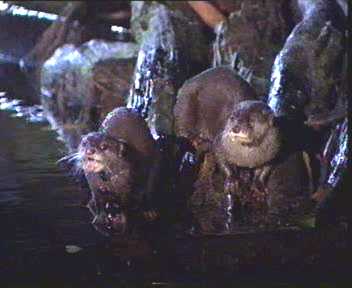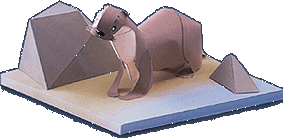|
Animal Spotlight
October 2002
Another dawn descends upon a remote fishing village by a gentle tributary of the Ganges River in India. The fishermen have risen very early and are preparing their fishing nets and sampan-like canoes for the morning fishing expedition. A series of excited bird-like squeaks accompany the fishermen and their canoes to the waters. Every morning, as many as 6 - 8 fishing canoes take their positions along the tributary and the fishermen then cast their nets into the murky waters. The accompanying squeaking sounds become more intense as the fish in the waters begin to panic and are driven into the waiting nets. The fish that avoided the nets in time are ambushed and gripped tightly by numerous unseen sharp teeth and dexterous claws. Day after day, the same events terrorize the fish in this quiet tributary. The harvest this morning is rather good. The fishermen have caught enough fish to eat and sell to the rangers of a nearby wildlife reserve. This catch would not be so successful without a little help from the fishermen's traditional fishing assistants - the otters. For countless centuries, the people of this remote village have trained and domesticated otters as fishing tools and assistants, just like the cormorants have been traditionally trained to catch fish for fishermen in China. But this age-old and traditional working relationship between man and otters is a fast disappearing trade. In recent years, more and more young men from the village are migrating to the towns and cities to look for jobs and a better life. If this continues, the younger generation of the village will eventually distance themselves not only from their tradition and family roots, but also from their unique relationship with the wildlife that their ancestors grew up with, the animals that they had learnt to cherish and respect. Will these young men ever return to help conserve and protect the remaining natural habitats and wildlife around their village? Only time has the answers......
For further information about Otters, check out the following websites that contain a wealth of interesting facts on these creatures ! Otternet - http://otternet.com International Otter Survival Fund - http://www.otter.org
Activity Section: The paper animal above is modeled after a Japanese River Otter. But since all otters have similar built, it can pass off as an Oriental Small-clawed Otter too. This paper otter will lead to a page where you can also learn to make other paper animals. Enjoy !
Acknowledgements - Facts from Wildlife Fact File and the above source websites, Photo from Night Safari vcd, and story of fishing otters derived from the otters' signboards along the Fishing Cat and Leopard Trail.
Back to
Home | Explore | Rangers’ Station | Walking Trails | Tram Ride | Resources
|
|||||||



